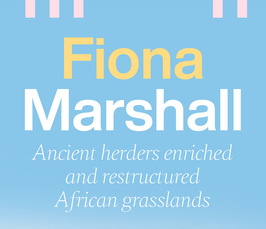Distinguished Lecture von Prof. Fiona Marshall: "Ancient herders enriched and restructured African grasslands"
Distinguished Lecturer Seminar Series
- Datum: 03.05.2019
- Uhrzeit: 13:30
- Vortragende(r): Prof. Fiona Marshall
- Department of Anthropology, Washington University in St. Louis, USA
- Ort: MPI SHH Jena
- Raum: Villa V14
- Gastgeber: Abteilung Archäologie
- Kontakt: bullion@shh.mpg.de

Grasslands are one of the world’s most extensive terrestrial biomes and
are central to the survival of herders, their livestock and diverse
communities of large wild mammals. In Africa, tropical soils are
predominantly
nutrient-limited but productive grassy patches in wooded grassland
savannah ecosystems grow on fertile soils created by geologic and
edaphic factors, megafauna, fire and termites. Mobile pastoralists also
create soil-fertility hotspots by penning their herds
at night, which concentrates excrement—and thus nutrients—from grazing
of the surrounding savannahs. Historical anthropogenic hotspots produce
high-quality forage, attract wildlife and increase spatial heterogeneity
in African savannahs. Archaeological research
suggests this effect extends back at least 1,000 years but little is
known about nutrient persistence at millennial scales. Here we use
chemical, isotopic and sedimentary analyses to show high nutrient and
15N enrichment in on-site degraded dung deposits relative
to off-site soils at five Pastoral Neolithic sites (radiocarbon dated
to between 3,700 and 1,550 calibrated years before present (cal. BP)).
This study demonstrates the longevity of nutrient hotspots and the
long-term legacy of ancient herders, whose settlements
enriched and diversified African savannah landscapes over three
millennia.